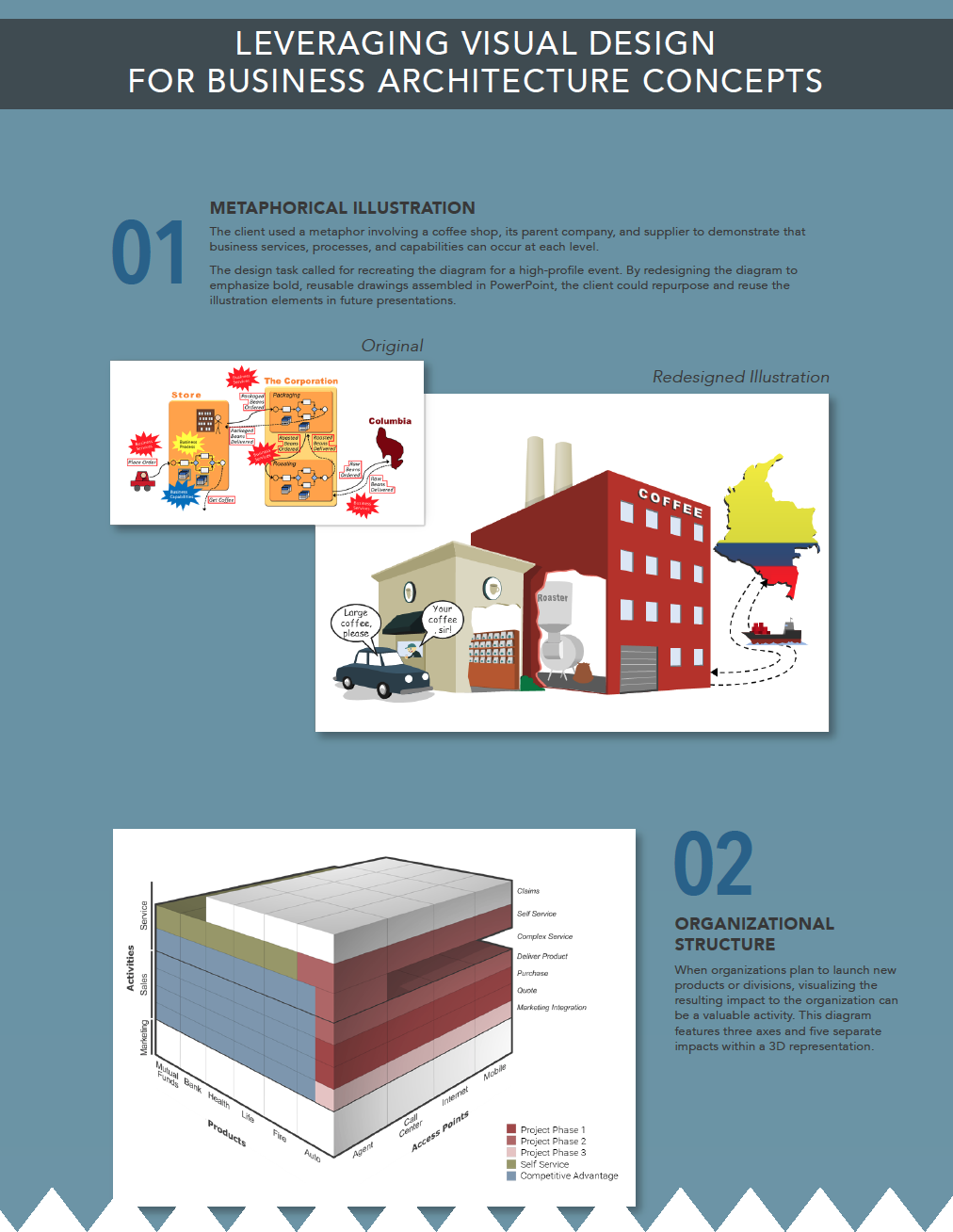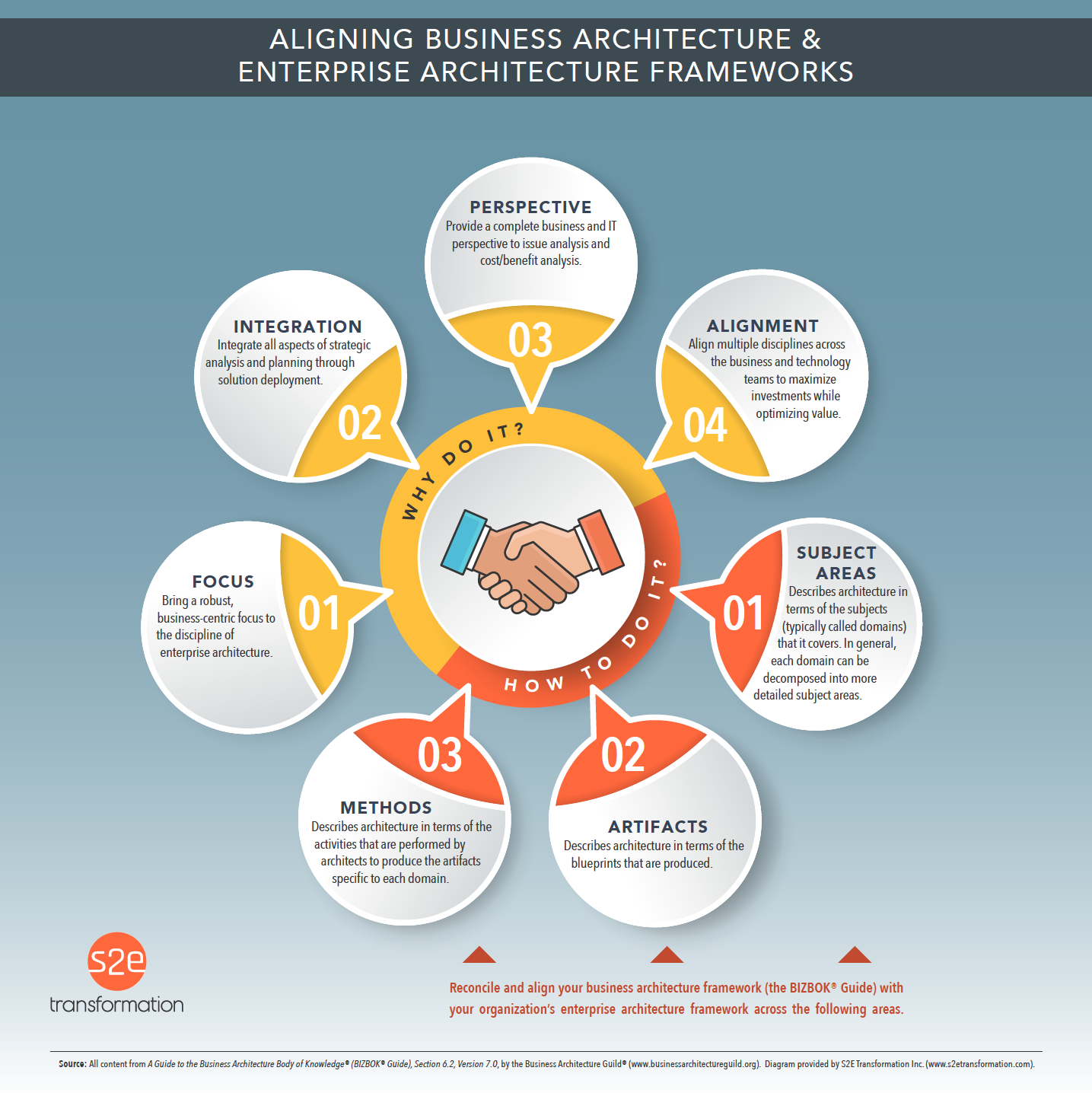![]() Welcome to Part 1 of 3 within our visual and storytelling StraightTalk series. We are excited for these posts because we think they are fresh, fun and most importantly—highly relevant to business architecture.
Welcome to Part 1 of 3 within our visual and storytelling StraightTalk series. We are excited for these posts because we think they are fresh, fun and most importantly—highly relevant to business architecture.
When we think about our business architecture practices, or even our competencies as business architects, we often focus on developing and using business architecture. While that is indeed the heart of what we do, to be successful, there are many other things we need to be good at—like presenting information both visually and verbally. This first installment in the series will explore presentation design. And we brought in an expert to help.
We spoke with James Jones, a rare individual who is not only a highly respected, experienced presentation designer—but one who spent many years of his career supporting a large business architecture team, designing everything from target architectures and strategic roadmaps, to executive presentations. In this unique podcast, James speaks with us about what presentation design is, why it is so vital for the success of business architecture practices, and how we, as practitioners, can develop some of the basics.
Disclaimer: we’ve made some adjustments for our typical StraightTalk-style: the headings represent StraightTalk asking the questions and our guest, James, responds in turn.
Don’t miss the StraightTalk podcast with James firsthand for even more valuable perspectives beyond what is in this post, which is an abbreviated version of our conversation.
P.S. Shout out to all the designers out there who help to shape and bring our architectural ideas to life in dazzling ways – including our StraightTalk designer who performs magic in every post!
What is the role of a presentation designer?
James: A true presentation designer acts as a strategic partner, who talks through the concepts for a work product (e.g., presentation, pitch deck, illustration, etc.) with the person requesting assistance, and then designs them accordingly to those needs and their expertise.
What are some of the most common things you create for business architecture teams?
James: With business architecture, the first thing that comes to mind is target architectures. These help to ground people on the current state (current state architecture diagrams) as well as the aspirational state (target architecture diagrams) and represent the information at a level of detail that is high enough for an executive to consume. I also produce many kickoff decks for various initiatives, to help people get on the same page and rally towards the same goal. I also produce roadmaps, explainer videos, and dashboards, and even work with executives to facilitate meetings and serve as a thought partner.
Download this diagram that has a few examples from James’ portfolio to see how to leverage visual design for business architecture concepts.
How does the process work between a presentation designer and the business architect (or other subject matter expert) with whom they are working?
James: For context, I find that the presentation design function is best done as a shared service within an organization. This provides good flexibility for designers to work across teams when the help is most needed.
As far as how the process works, I typically use an informal intake process, without too many layers of extra forms or steps. Ideally, I like to meet with the architect first and talk through their context, purpose, and outcomes. I use this tool a lot to ground everyone and later make sure the work product meets the original intent. Sometimes we may work together interactively to rough out a presentation or illustration as well.
In addition to the well-designed outputs of course, what makes working with a presentation designer so valuable?
James: I am typically not the expert in the room, so that allows me to have a fresh perspective on the work product that others may have been heads down on for so long. Aside from that, as I speak to an architect, I am continually drawing the concept out in my head, and if I can’t make sense of it, I will keep asking questions until I do—which can ultimately help to shape and make a concept more clear.
Why is good presentation design so crucial for a business architecture practice? Why isn’t the content itself enough?
James: Architecture is typically not understood at a glance. It can be complicated, it may have layers to it, and it is sometimes ambiguous and needs to be more relatable. Many times it may be introducing new ideas or concepts that perhaps an executive hasn’t seen before, and they really can’t get their head around it quickly, without an analogy or a way to help them understand the problem. Design serves to help make the content relatable to the audience. A designer can work through complicated and ambiguous concepts and help make them more tangible.
On top of that, you need brevity. Many times an architect is so close to the subject and all of its depth and connections, so working with a designer can help to make the work product concise, clear and consumable—and make sure it meets the original communication objective.
Of course, presentation designers also make sure that the final product adheres to design principles, such as those for the appropriate use of color, white space and things like that.
Some business architecture teams utilize presentation designers, a highly recommended practice where feasible. However, what are the top things we can learn to do better in order to leverage visual designs ourselves?
James: The first thing is to take the time to learn whatever tool you use, PowerPoint, Visio or something else. I typically use PowerPoint because it is the number one tool being used in business today for these types of outputs—and it is very robust. Within PowerPoint, there are some basic things you can do to make sure your work is polished like aligning shapes properly and using color with intention. Also, try to get to your point as quickly as possible and remove any extra content, by simplifying it or moving it to an appendix.
Two of the most valuable resources that I use regularly are Unsplash, which is a website for royalty-free images that are high quality and Diagrammer which is a Duarte tool where you can find a diagram you like and download it, saving you a ton of time.
Anything else?
James: The emerging field of presentation design is becoming more popular, and we can expect to see more designers paired with the business teams in the future. If you do work with a designer, treat it as if you are the art director—give them the direction and strategic intent, but let them design and then iterate together.
“Business and IT architecture and presentation design are perfect complements. Architecture is not always understood at a glance, especially when the concepts are complex and multi-layered. However, good presentation design ensures that those important ideas are presented with brevity and are relatable and tangible for the intended audience. Together these disciplines can create, communicate and compel people to understand and act upon the critical and transformational ideas that will help shape the future of our organizations.” – James Jones
More Good Stuff…
20-Minutes With James Jones (StraightTalk podcast): Just in case you missed the link earlier in this post, make sure to listen to the engaging podcast by James, which was the basis for this post.
Unsplash: A resource recommended by James with a gold mine of beautiful and free photos.
Diagrammer (Nancy Duarte): Another resource recommended by James with 4,000 customizable diagrams you can download. Score.
Adobe Color CC: One more great resource from James with color palettes.
slide:ology: The Art and Science of Creating Great Presentations (Nancy Duarte): A must-read, highly useful guide with practical approaches to visual story development from a true guru. It’s a classic.
The Blog (Nancy Duarte): Amazing resources and blog from Nancy Duarte.
Presentation Tips (Garr Reynolds): Presentation tips from another guru.
Works by Edward R. Tufte: Well-known Yale University professor (emeritus), political scientist, statistician, and the author of seminal information design books. Here is a list of his classics that are loved and admired by many (including us).
- The Visual Display of Quantitative Information
- Visual Explanations: Images and Quantities, Evidence and Narrative
- Envisioning Information
- Beautiful Evidence
The Presentation Secrets of Steve Jobs: How to Be Insanely Great in Front of Any Audience (book by Carmine Gallo): A step-by-step guide that shows you how to use Steve Jobs’s crowd-pleasing techniques in your own presentations. Here’s an article that provides an abbreviated view on the topic.
Good Business Architecture-Related Content Visualizations: Learn from your friends. Here are just a few examples from previous Business Architecture Guild® Summits where business architects have used excellent visuals to convey their complex and important ideas for the practice or application of business architecture.
- Business Architecture and Using Business Architecture For Strategy Planning (ABN AMRO, 2017 and 2016)
- Tying Business Architecture to Business Strategy (State Farm, 2016)
- Bending Trends With Business Architecture and Business Architecture at Humana (Humana, 2017 and 2016)
- Aligning Design With Architecture (Mike Clark, 2014)
16 Superb TED Talks Every Designer Should Watch (TED Talk): A compilation of inspirational talks from some of the world’s brightest and best designers and innovators.


